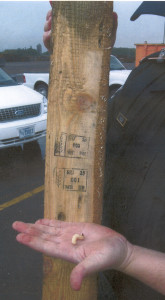
Do we want triple the current number of wood-boring non-native insects to be established in just 35 years? We all know the damage that some of these insects can do (see summary or longer descriptions; for specific insects).
Over the past 30 years, at least 58 non-native species of wood- or bark-boring insects have been detected in the United States (not quite 2 new insects per year). Most were presumably introduced via imported wood, especially wood packaging (Haack et al.).
Yes, the U.S. has implemented the International Standard for Phytosanitary Management (ISPM)#15. Nevertheless, USFS researcher Bob Haack estimates that 13,000 shipping containers per year – or 35 per day – transport tree-killing pests to the U.S. This is the basis for an estimate that by 2050 – just 35 years from now – the number of wood-boring pests introduced to the country will triple above current levels.
We don’t need to rely only on extrapolations to know that APHIS’ implementation of ISPM#15 is not protecting our trees. As noted in my blog of 11 September, inspectors at the ports continue to find insects in wood packaging – even wood packaging marked as having been treated according to the requirements of the standard. Nearly half of the wood packaging entering the country that does not comply with the treatment requirements comes from Mexico. U.S. and Mexican forests are separated by deserts – allowing insects to evolve there to which our trees are vulnerable (see my blog from 11 September and descriptions of goldspotted oak borer, soapberry borer, and walnut twig beetle and its accompanying fungus here).
An on-going study seeks to identify insect larvae found in wood packaging; it is a cooperative effort of USDA APHIS’ laboratory at Otis, Massachusetts, and Customs and Border Protection staff at eight ports. Since 2012, these ports have sent 848 cerambycid and buprestid beetle larvae to Otis for identification. The APHIS scientists have succeeded in identifying 292 larvae, or only 34%. They constituted 39 species and 29 genera.
At least 44 of these insects were from China; they included 6 Asian longhorned beetles. Remember, the U.S. first adopted regulations requiring China to treat its wood packaging at the end of 1998 – nearly 17 years ago!!! Another 20 insects were from Russia – which has been required to treat its wood packaging since early 2006 – nearly 10 years ago.
As noted in the documents linked to above, and in earlier blogs (15 July, 22 and 31 August, 11 September), wood-boring pests collectively have been the most costly of the types of tree-killing pests introduced. One study estimated that they cost local governments and homeowners $2.4 billion each year to manage dying and dead trees. The homeowners lose another $830 million in residential property values.
What the Government Has Done
While USDA APHIS has cracked down on U.S. producers of wood packaging who cheat and is promoting workshops to educate our trade partners on wood packaging treatment requirements, the government should do more to protect our forests.
What More Can be Done
• At present, U.S. policy allows an importer to be caught 5 times in 1 year with wood packaging that does not comply with the regulatory requirements. Requirements adopted a decade or more ago should be enforced more strictly! The Bureau of Customs and Border Protection and USDA APHIS should instead penalize all importers whose wood packaging does not comply with regulatory requirements.
• The Bureau of Customs and Border Protection should incorporate the wood packaging requirements into its “Customs-Trade Partnership Against Terrorism” (C-TPAT) program .
• USDA APHIS should re-examine the economic pros and cons of requiring importers to switch to packaging made from materials other than wooden boards. The new review should incorporate the high economic and ecological costs imposed by insects introduced via the wood packaging pathway.
• USDA leadership should move forward and the President’s Office of Management and Budget should approve final regulations – proposed by APHIS 5 years ago! – that would apply the same treatment requirements to wood packaging used in trade between the US and Canada. (Canada has been ready to adopt this measure for several years.)
Sources (my apologies – I apparently cannot attach to specific points in the blog):
Aukema, J.E., B. Leung, K. Kovacs, C. Chivers, K. O. Britton, J. Englin, S.J. Frankel, R. G. Haight, T. P. Holmes, A. Liebhold, D.G. McCullough, B. Von Holle.. 2011. Economic Impacts of Non-Native Forest Insects in the Continental United States PLoS One September 2011 (Volume 6 Issue 9)
Haack RA, Britton KO, Brockerhoff EG, Cavey JF, Garrett LJ, et al. (2014) Effectiveness of the International Phytosanitary Standard ISPM No. 15 on Reducing Wood Borer Infestation Rates in Wood Packaging Material Entering the United States. PLoS ONE 9(5): e96611. doi:10.1371/journal.pone.009661
Leung, B., M.R. Springborn, J.A. Turner, E.G. Brockerhoff. 2014. Pathway-level risk analysis: the net present value of an invasive species policy in the US. The Ecological Society of America. Frontiers of Ecology.org
Posted by Faith Campbell